 Revised Article UPDATED: 6/5/15 / New total LSA and LSA-like chart (at bottom) — At best statistics can be fluid and hard to state precisely. In response to my request for any Australian input below, Neil Jansen responded, “I found some data sourced from the authority that manages such aircraft categories in Australia (Recreational Aviation Australia).” He attached a PDF article. After my review of this document, I can say that I was not grossly off in my guesstimate of 2,000 LSA-type aircraft. I attempted to be conservative and evidently I was. From a review of the charts and article, I would now increase my Australia figures from 2,000 to perhaps 2,700 so the final calculus of around 50,000 worldwide aircraft looks even more solid. That said, my European counterpart, Jan Fridrich, and I since had a conversation that suggests even 50,000 may not fully cover it.
Revised Article UPDATED: 6/5/15 / New total LSA and LSA-like chart (at bottom) — At best statistics can be fluid and hard to state precisely. In response to my request for any Australian input below, Neil Jansen responded, “I found some data sourced from the authority that manages such aircraft categories in Australia (Recreational Aviation Australia).” He attached a PDF article. After my review of this document, I can say that I was not grossly off in my guesstimate of 2,000 LSA-type aircraft. I attempted to be conservative and evidently I was. From a review of the charts and article, I would now increase my Australia figures from 2,000 to perhaps 2,700 so the final calculus of around 50,000 worldwide aircraft looks even more solid. That said, my European counterpart, Jan Fridrich, and I since had a conversation that suggests even 50,000 may not fully cover it.REVISED: World Aviation Statistics with New Data
Revised Article UPDATED: 6/5/15 / New total LSA and LSA-like chart (at bottom) — At best statistics can be fluid and hard to state precisely. In response to my request for any Australian input below, Neil Jansen responded, “I found some data sourced from the authority that manages such aircraft categories in Australia (Recreational Aviation Australia).” He attached a PDF article. After my review of this document, I can say that I was not grossly off in my guesstimate of 2,000 LSA-type aircraft. I attempted to be conservative and evidently I was. From a review of the charts and article, I would now increase my Australia figures from 2,000 to perhaps 2,700 so the final calculus of around 50,000 worldwide aircraft looks even more solid. That said, my European counterpart, Jan Fridrich, and I since had a conversation that suggests even 50,000 may not fully cover it. However, better to be conservative on such estimates, I believe. —DJ

Weather forecasting is much better today, but statistics can often be wrong despite best efforts. Along this line, I heard from a reader, an engineer in Italy, “In your article ‘Analyzing Statistics on Worldwide Aviation,’ you did not mention my country.”

My Italian reader, who preferred I did not use his name, wrote, “Apart from being the country from where several LSA aircraft arrive — he mentions Tecnam, which may be the largest LSA and light aircraft producer on the planet — we have over 13,000 registered “ultralight” aircraft with the Aeroclub of Italy (a national institution managing registrations of ultralight aircraft, including gyrocopters and helicopters).” I add that Germany does something similar with its DAeC and DULV, which might account for GAMA having zero information about microlights in Germany, a nation I know to have a significant number of such aircraft.

“The reason why [the aircraft count] is not so obvious,” he further clarified, “is that the certification of pilots and aircraft is done outside of ENAC (Italian equivalent of FAA) and therefore does not get reported in the usual channels where numbers of registered aircraft are accounted.”
“Ultralight (generally meaning the European name for light two seaters, not the U.S. superlight single seaters) registrations for Italy follow the [aircraft registration] format I-1234, or I-A123 now that we passed 10,000 registrations. I have seen I-C1xx (can’t remember the exact number, but it means that we passed 13,000 registrations already).” He added, “I think we had over 2,000 in the last five years or so.”

“So, despite the obvious intention of keeping a low profile to make sure that the Revenue Service does not develop some new creative tax to hit a vulnerable sector, it looks like there are plenty of pilots and planes filling our skies,” the Italian writer concluded. He then invited, “Come visit and we’ll be happy to show you around.” That’s an offer I’d like to take when I also wish to visit the large Tecnam facility in Italy.
My source finished his message saying, “I fly a older Aeronca with American N-numbers using an FAA Private certificate and therefore I don’t even show up in that list.”
I also managed to overlook two other countries of note. My apology and the only excuse I can offer is that GAMA assembled a great deal of info and I simply did not absorb it all. However, the news is good for the light aircraft sector as the numbers rose considerably from my first estimate of about 40,000 light and/or sport aircraft in the world.
I still don’t know exactly how to evaluate Australia’s numbers — as they did not break out the LSA-type group in any identifiable way — but I would conservatively guess their microlight/LSA/VLA sector could have around 2,000 light or sport aircraft. If someone in that country knows better, please do educate me. I’d like for these reviews to be as accurate as possible.
However, neighboring New Zealand offered more data. Their listing through me off as they switched methods after 2005 and again after 2010. Yet based on further study, I can see they show 1,059 “microlights” and they once showed a high, in 2009 of 1,853 “Sport” aircraft. From this I might guess they have around 2,000 of what might be called LSA-types.
So, with good Italy info and more from down under, I feel reasonably confident reporting that pilots around the globe fly somewhere around 50,000 light, sport, recreational aircraft.
The update of substantial information about Italy and my further pondering of the many pages in GAMA’s detailed report suggest two things to me. First, statistics are devilishly hard to obtain and are subject to all sorts of inconsistencies, many of human origin. Secondly, no matter how you cut it, light and sport aircraft are a very substantial sector of the worldwide family of aircraft.
Here you can examine our chart for LSA and LSA-like aircraft around the world. Please consider all the notes to interpret the figures.
 Revised Article UPDATED: 6/5/15 / New total LSA and LSA-like chart (at bottom) — At best statistics can be fluid and hard to state precisely. In response to my request for any Australian input below, Neil Jansen responded, “I found some data sourced from the authority that manages such aircraft categories in Australia (Recreational Aviation Australia).” He attached a PDF article. After my review of this document, I can say that I was not grossly off in my guesstimate of 2,000 LSA-type aircraft. I attempted to be conservative and evidently I was. From a review of the charts and article, I would now increase my Australia figures from 2,000 to perhaps 2,700 so the final calculus of around 50,000 worldwide aircraft looks even more solid. That said, my European counterpart, Jan Fridrich, and I since had a conversation that suggests even 50,000 may not fully cover it.
Revised Article UPDATED: 6/5/15 / New total LSA and LSA-like chart (at bottom) — At best statistics can be fluid and hard to state precisely. In response to my request for any Australian input below, Neil Jansen responded, “I found some data sourced from the authority that manages such aircraft categories in Australia (Recreational Aviation Australia).” He attached a PDF article. After my review of this document, I can say that I was not grossly off in my guesstimate of 2,000 LSA-type aircraft. I attempted to be conservative and evidently I was. From a review of the charts and article, I would now increase my Australia figures from 2,000 to perhaps 2,700 so the final calculus of around 50,000 worldwide aircraft looks even more solid. That said, my European counterpart, Jan Fridrich, and I since had a conversation that suggests even 50,000 may not fully cover it.






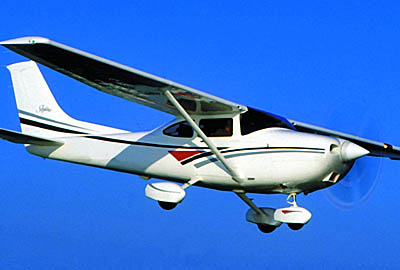 Thanks to a solid effort by
Thanks to a solid effort by  To provide some perspective, let’s look at certified GA aircraft first. From its peak in 1978, U.S.-manufactured GA deliveries have fallen dramatically, by 93% from 14,398 single engine piston aircraft in 1978 to 986 in 2014. Fortunately, since 2000 the continuing drop is less severe, for example in 2006, worldwide GAMA members reported delivering a new millennia peak of 2,513 aircraft; the decline to 986 is a drop of 61%. The ’60s and ’70s were clearly the “golden era” for GA piston airplane production. Accounting for this drop, beside pilot population decreases (see below) and airplanes lasting so long — the average age of four seater is 38.2 years old — most competition likely came from non-flying activities. Among aircraft choices, Experimentals in the last two decades have grown 143% to nearly 25,000 aircraft. LSA in fully built or kit form add to GA’s competition although much less so partly as Experimentals have been around much longer.
To provide some perspective, let’s look at certified GA aircraft first. From its peak in 1978, U.S.-manufactured GA deliveries have fallen dramatically, by 93% from 14,398 single engine piston aircraft in 1978 to 986 in 2014. Fortunately, since 2000 the continuing drop is less severe, for example in 2006, worldwide GAMA members reported delivering a new millennia peak of 2,513 aircraft; the decline to 986 is a drop of 61%. The ’60s and ’70s were clearly the “golden era” for GA piston airplane production. Accounting for this drop, beside pilot population decreases (see below) and airplanes lasting so long — the average age of four seater is 38.2 years old — most competition likely came from non-flying activities. Among aircraft choices, Experimentals in the last two decades have grown 143% to nearly 25,000 aircraft. LSA in fully built or kit form add to GA’s competition although much less so partly as Experimentals have been around much longer. The number of airmen — pilots with certificates — explains some of the aircraft delivery decreases. From a peak in GAMA’s numbers of 827,071 licensed pilots in 1980 to the current number of 593,499, I calculate a drop of 28% over 34 years. Keep in mind that nearly 47,000 of those airmen are not Americans but foreign nationals holding a U.S. certificate. Private Pilots have dropped by 51%, but many of those probably went on to higher ratings as ATPs grew by 120% in the same period to account for 26% of all certificate holders. No doubt related to that, CFIs grew by 67% to become 17% of all certificate holders and pilots with Instrument ratings also increased by 18%. Those holding a Spot Pilot certificate now totals 5,157, reported GAMA, while Recreational Pilot peaked at 343 in 1999 and has since shrunk to only 220 certificates. Neither of the last two amount to even 1% of all license holders though the other certificate categories have several decades of history the newer ones lack.
The number of airmen — pilots with certificates — explains some of the aircraft delivery decreases. From a peak in GAMA’s numbers of 827,071 licensed pilots in 1980 to the current number of 593,499, I calculate a drop of 28% over 34 years. Keep in mind that nearly 47,000 of those airmen are not Americans but foreign nationals holding a U.S. certificate. Private Pilots have dropped by 51%, but many of those probably went on to higher ratings as ATPs grew by 120% in the same period to account for 26% of all certificate holders. No doubt related to that, CFIs grew by 67% to become 17% of all certificate holders and pilots with Instrument ratings also increased by 18%. Those holding a Spot Pilot certificate now totals 5,157, reported GAMA, while Recreational Pilot peaked at 343 in 1999 and has since shrunk to only 220 certificates. Neither of the last two amount to even 1% of all license holders though the other certificate categories have several decades of history the newer ones lack. Where I could identify microlights, ultralights, or LSA types, I calculated 19,613 aircraft in what might be called “greater Europe” (mostly EU countries). Making an informed guess of at least 4,000 “microlight/ultralight” for Germany — which country, as noted above, did not supply a detailed value for this category — and adding non-European countries such as South Africa (6,072 including “Sport, Recreational, and Experimental”), Canada (7,125 “ultralights”), and Brazil plus Asian countries (small counts for several nations), I make a best estimate of about 40,000 LSA-type aircraft outside the USA. This figure includes estimates for Sweden and Switzerland that did not break out their reporting. Also included in the 40,000 count is England with strong numbers of 4,029 “microlights” and 3,269 “Fixed Wing Aeroplanes of less than 750 kilograms” (1,650 pounds). See updated figures in
Where I could identify microlights, ultralights, or LSA types, I calculated 19,613 aircraft in what might be called “greater Europe” (mostly EU countries). Making an informed guess of at least 4,000 “microlight/ultralight” for Germany — which country, as noted above, did not supply a detailed value for this category — and adding non-European countries such as South Africa (6,072 including “Sport, Recreational, and Experimental”), Canada (7,125 “ultralights”), and Brazil plus Asian countries (small counts for several nations), I make a best estimate of about 40,000 LSA-type aircraft outside the USA. This figure includes estimates for Sweden and Switzerland that did not break out their reporting. Also included in the 40,000 count is England with strong numbers of 4,029 “microlights” and 3,269 “Fixed Wing Aeroplanes of less than 750 kilograms” (1,650 pounds). See updated figures in 




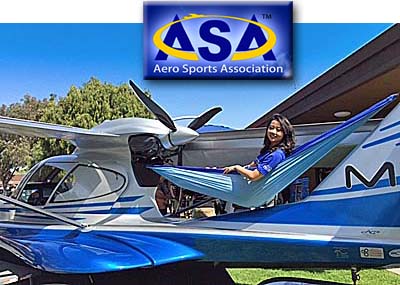

 WEEKEND UPDATE — Next week I leave for my first visit to China, specifically to Anyang City, by train a couple hours south of Beijing where the seventh running of an annual airshow is planned. I have only a sketchy idea what to expect even though Shu Dong Li of the
WEEKEND UPDATE — Next week I leave for my first visit to China, specifically to Anyang City, by train a couple hours south of Beijing where the seventh running of an annual airshow is planned. I have only a sketchy idea what to expect even though Shu Dong Li of the  In an interesting coincidence, I discovered a story about a Chinese fellow who built his own ultralight from available materials and took to the air in it. He’s not alone in this, of course, but I found his work an intriguing example of ordinary Chinese citizens showing an interest in flying for fun.
In an interesting coincidence, I discovered a story about a Chinese fellow who built his own ultralight from available materials and took to the air in it. He’s not alone in this, of course, but I found his work an intriguing example of ordinary Chinese citizens showing an interest in flying for fun. The two news organizations reported that on a recent Sunday Yang successfully took off and landed 10 times in Jilin province, located in northeast China. According to writer Emily Chan he took the airplane up to 650 feet and has since logged 2.5 hours of flying time.
The two news organizations reported that on a recent Sunday Yang successfully took off and landed 10 times in Jilin province, located in northeast China. According to writer Emily Chan he took the airplane up to 650 feet and has since logged 2.5 hours of flying time. As I looked at the photos for this airplane I knew it looked familiar, in particular a
As I looked at the photos for this airplane I knew it looked familiar, in particular a 
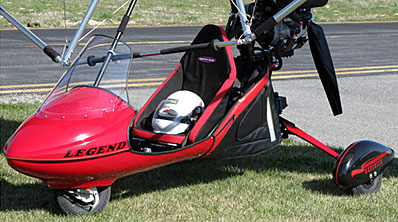

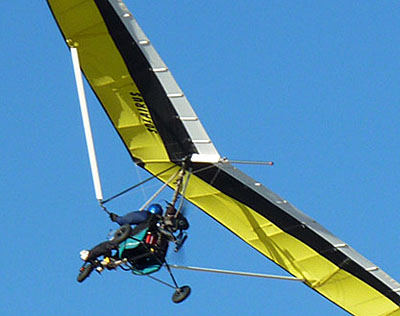


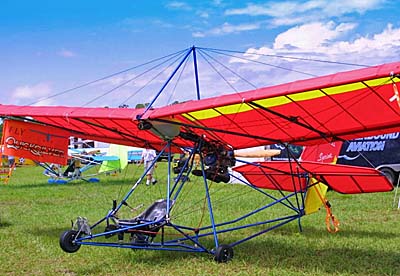




 Earlier I’ve written that the Part 103 ultralight sector seemed more vibrant than ever at this year’s Sun ‘n Fun. I admit a bias. I love Part 103 … the aircraft, the concept, I like flying single seat aircraft, and, hugely, I love that Part 103 deftly avoids most of the interference from government officials that tends to dominate so much of aviation worldwide. While certified aircraft have hundreds or thousands of pages of regulations they must follow, Part 103’s entire ruleset can be printed on the front and back of a single piece of paper. That’s fantastic!
Earlier I’ve written that the Part 103 ultralight sector seemed more vibrant than ever at this year’s Sun ‘n Fun. I admit a bias. I love Part 103 … the aircraft, the concept, I like flying single seat aircraft, and, hugely, I love that Part 103 deftly avoids most of the interference from government officials that tends to dominate so much of aviation worldwide. While certified aircraft have hundreds or thousands of pages of regulations they must follow, Part 103’s entire ruleset can be printed on the front and back of a single piece of paper. That’s fantastic! Of course I couldn’t weigh each machine out in the fields of Sun ‘n Fun’s Paradise City, but I did probe with each vendor interviewed, “Are you certain this meets Part 103’s parameters faithfully?” Each answered, “Yes!” although they also noted that customers sometimes like to add options that can push the vehicle out of 103.
Of course I couldn’t weigh each machine out in the fields of Sun ‘n Fun’s Paradise City, but I did probe with each vendor interviewed, “Are you certain this meets Part 103’s parameters faithfully?” Each answered, “Yes!” although they also noted that customers sometimes like to add options that can push the vehicle out of 103. As you look at the lead photo, you have to wonder if this thing just crashed and jumbled its tubing into a mess. You can be excused for wondering. However, what you see above is Rev in compact — and wheeled — form so it can be moved around easily inside a hangar or onto a trailer. Because Part 103 trikes are limited to 60 mph, owners may trailer their rig; also, an enclosed trailer can make an inexpensive hangar.
As you look at the lead photo, you have to wonder if this thing just crashed and jumbled its tubing into a mess. You can be excused for wondering. However, what you see above is Rev in compact — and wheeled — form so it can be moved around easily inside a hangar or onto a trailer. Because Part 103 trikes are limited to 60 mph, owners may trailer their rig; also, an enclosed trailer can make an inexpensive hangar.


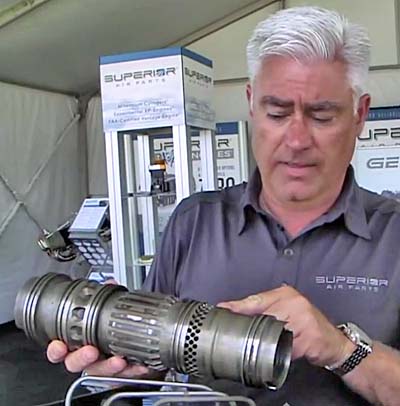
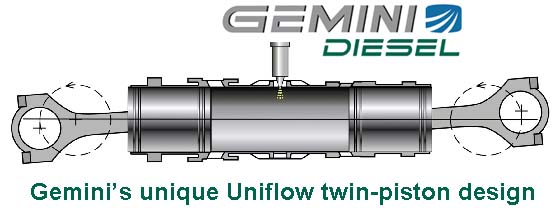


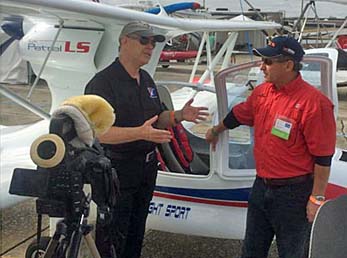








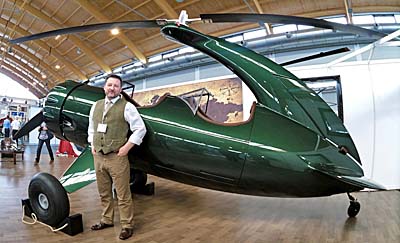
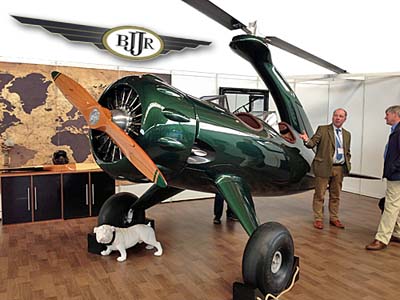 A few light aircraft are located in the “A” halls, partly due to available space being taken in the “B” halls and possibly as those vendors prefer to be on the GA side of the event. Most of the avionics, headset, and traditional aircraft companies are in the “A” side and some light aircraft manufacturers may see those buyers as their primary market. This is especially true for more costly aircraft or those that exceed the U.S. LSA category by virtue of having retractable landing gear and in-flight adjustable props.
A few light aircraft are located in the “A” halls, partly due to available space being taken in the “B” halls and possibly as those vendors prefer to be on the GA side of the event. Most of the avionics, headset, and traditional aircraft companies are in the “A” side and some light aircraft manufacturers may see those buyers as their primary market. This is especially true for more costly aircraft or those that exceed the U.S. LSA category by virtue of having retractable landing gear and in-flight adjustable props. Let’s clarify. This is not Auto Gyro, the largest producer of modern gyroplanes. Neither is Bulldog a conventional gyroplane. It is an autogyro, meaning the classic taildragging, engine-in-front, more conventional airplane-looking, rotary-winged aircraft. One of the most well-known autogyros is the
Let’s clarify. This is not Auto Gyro, the largest producer of modern gyroplanes. Neither is Bulldog a conventional gyroplane. It is an autogyro, meaning the classic taildragging, engine-in-front, more conventional airplane-looking, rotary-winged aircraft. One of the most well-known autogyros is the  Why create such a graceful curved mast? Is it yet another feature to distinguish this unique aircraft. Yes and no. No, in that it is not just art, though it has that quality. Yes, in that it has real merit from a safety standpoint. Barry observed, “All helicopters and autogyros with tail sections to position a tail rotor or rudder to the rear of the aircraft can suffer from incidents when a rotor blade strikes the tail section. Through the Bulldog’s design, we have been able to completely remove this threat to pilots.”
Why create such a graceful curved mast? Is it yet another feature to distinguish this unique aircraft. Yes and no. No, in that it is not just art, though it has that quality. Yes, in that it has real merit from a safety standpoint. Barry observed, “All helicopters and autogyros with tail sections to position a tail rotor or rudder to the rear of the aircraft can suffer from incidents when a rotor blade strikes the tail section. Through the Bulldog’s design, we have been able to completely remove this threat to pilots.”


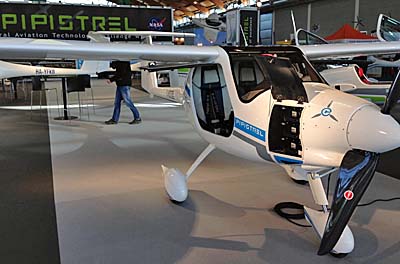


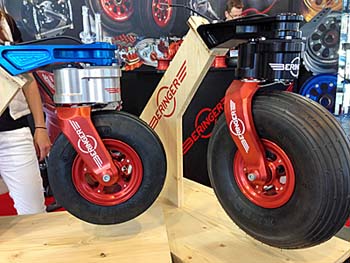

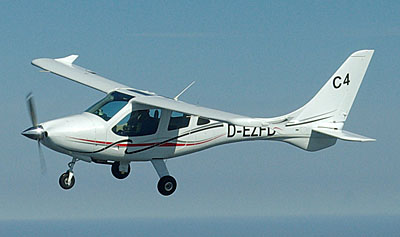








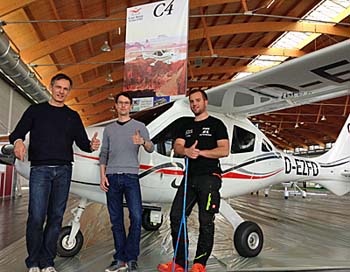

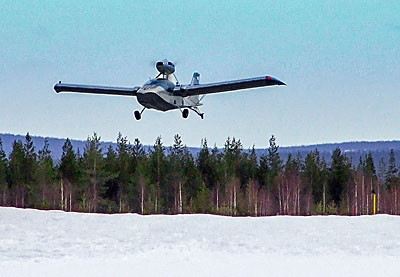











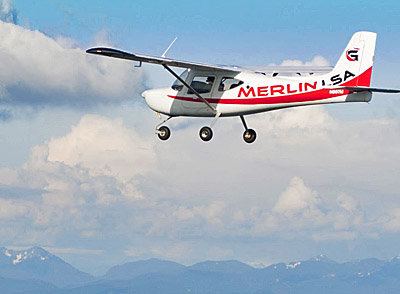



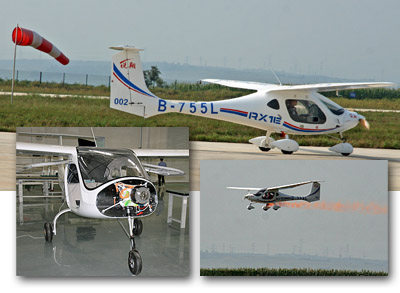 With
With  Some companies will not be attending not because their projects have stopped but because they are at critical junctions. Among those missing will be the Volocopter from e-Volo nor any man-carrying aircraft display by Yuneec — which last year showed their eSpyder that had just won German approval. However, the company will be present with their drone/UAV models and their electric powered skateboards, the latter seen at AirVenture 2013.
Some companies will not be attending not because their projects have stopped but because they are at critical junctions. Among those missing will be the Volocopter from e-Volo nor any man-carrying aircraft display by Yuneec — which last year showed their eSpyder that had just won German approval. However, the company will be present with their drone/UAV models and their electric powered skateboards, the latter seen at AirVenture 2013. Willi wrote, “A newcomer at the e-flight-expo is Chip Erwin from Florida. His company
Willi wrote, “A newcomer at the e-flight-expo is Chip Erwin from Florida. His company 